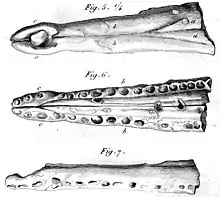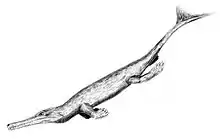| Metriorhynchus Temporal range: Kimmeridgian, | |
|---|---|
 | |
| Partial holotype rostrum (MHNG V-2232) of M. brevirostris as illustrated in 1824 | |
| Scientific classification | |
| Domain: | Eukaryota |
| Kingdom: | Animalia |
| Phylum: | Chordata |
| Class: | Reptilia |
| Clade: | Archosauria |
| Clade: | Pseudosuchia |
| Clade: | Crocodylomorpha |
| Suborder: | †Thalattosuchia |
| Family: | †Metriorhynchidae |
| Genus: | †Metriorhynchus von Meyer, 1832[1] |
| Species: | †M. brevirostris |
| Binomial name | |
| †Metriorhynchus brevirostris (Holl, 1828) vide Young et al., 2020[2] | |
| Synonyms | |
| |
Metriorhynchus is an extinct genus of marine crocodyliform that lived in the oceans during the Late Jurassic. The type species, M. brevirostris was named in 1829 as a species of Steneosaurus before being named as a separate genus by the German palaeontologist Christian von Meyer in 1832.[1] The name Metriorhynchus means "Moderate snout", and is derived from the Greek Metrio- ("moderate") and -rhynchos ("snout").
Discovery and species
Fossil specimens referrable to Metriorhynchus are known from Kimmeridgian (Late Jurassic) deposits of France.[2]
Valid species
Only one valid species is recognized today, the type species M. geoffroyii (now called M. brevirostris).[2] "Metriorhynchus" hastifer and "M." palpebrosus are generically distinct from the Metriorhynchus type species, with hastifer being recovered as a geosaurine.[3][4] Species in this genus were traditionally classed into two skull groups: longirostrine (long, narrow jaws) and brevirostrine (short, broad jaws). However, most of brevirostrine species have been transferred to the genera Purranisaurus and Suchodus.[5][6] Metriorhynchus superciliosus was also shown to be generically distinct from the type species, M. brevirostris, and now has its own genus Thalattosuchus.[2]

The genera Purranisaurus and Suchodus have been considered junior synonyms of Metriorhynchus.[7] Recent phylogenetic analyses however, do not support the monophyly of Metriorhynchus, as believed during the 1860s-2010.[8][9][10][2]
Eudes-Deslongchamps (1867–69) recognized four Callovian species of Metriorhynchus: M. superciliosus, M. moreli, M. blainvillei, and M. brachyrhynchus.[11] Later, Andrews (1913) considered there to be seven valid species: M. superciliosus, M. moreli, M. brachyrhynchus, M. durobrivensis, M. cultridens, M. leedsi and M. laeve.[12] However, Adams-Tresman (1987), using linear morphometrics, could only distinguish between the two skull groups, so she found there to be two species from the Oxford Clay, M. superciliosus and M. brachyrhynchus.[13] Vignaud (1997) however, considered there to be three Callovian species: M. superciliosus, M. brachyrhynchus and M. leedsi,[14] and a 2022 study describing a new metriorhynchid specimen advocated returning to this taxonomic system, considering Gracilineustes and Thalattosuchus junior synonyms of Metriorhynchus.[15]
Unnamed species
Fragmentary remains attributed to Metriorhynchus are known from South America during the Bajocian[16] and Bathonian (both Middle Jurassic).[17] However, phylogenetic analysis has shown that these species cannot be referred to Metriorhynchus.[5][18][2]
See also
References
- 1 2 von Meyer H. (1832). Palaeologica zur Geschichte der Erde und ihrer Geschöpfe. Frankfurt am Main: Siegmund Schmerber, 560.
- 1 2 3 4 5 6 Young, Mark T; Brignon, Arnaud; Sachs, Sven; Hornung, Jahn J; Foffa, Davide; Kitson, James J N; Johnson, Michela M; Steel, Lorna (2020-11-03). "Cutting the Gordian knot: a historical and taxonomic revision of the Jurassic crocodylomorph Metriorhynchus". Zoological Journal of the Linnean Society. 192 (2): 510–553. doi:10.1093/zoolinnean/zlaa092. ISSN 0024-4082.
- ↑ Ősi, Attila; Young, Mark T.; Galácz, András; Rabi, Márton (2018-05-10). "A new large-bodied thalattosuchian crocodyliform from the Lower Jurassic (Toarcian) of Hungary, with further evidence of the mosaic acquisition of marine adaptations in Metriorhynchoidea". PeerJ. 6: e4668. doi:10.7717/peerj.4668. ISSN 2167-8359. PMC 5949208. PMID 29761038.
- ↑ Foffa, Davide; Young, Mark; Brusatte, Stephen (2018). "Filling the Corallian gap: new information on Late Jurassic marine reptile faunas from England". Acta Palaeontologica Polonica. 63. doi:10.4202/app.00455.2018. hdl:20.500.11820/729f4cac-6217-4a21-b22c-8683b38c733b. ISSN 0567-7920. S2CID 52254345.
- 1 2 Young, Mark T.; Brusatte, Stephen L.; Ruta, Marcello; De Andrade, Marco Brandalise (2010-03-30). "The evolution of Metriorhynchoidea (mesoeucrocodylia, thalattosuchia): an integrated approach using geometric morphometrics, analysis of disparity, and biomechanics". Zoological Journal of the Linnean Society. 158 (4): 801–859. doi:10.1111/j.1096-3642.2009.00571.x. ISSN 0024-4082. S2CID 84592894.
- ↑ Herrera, Yanina; Gasparini, Zulma; Fernández, Marta S. (2015-02-20). "Purranisaurus potens Rusconi, an enigmatic metriorhynchid from the Late Jurassic–Early Cretaceous of the Neuquén Basin". Journal of Vertebrate Paleontology. 35 (2): e904790. doi:10.1080/02724634.2014.904790. hdl:11336/13737. ISSN 0272-4634. S2CID 128937976.
- ↑ Steel R. 1973. Crocodylia. Handbuch der Paläoherpetologie, Teil 16. Stuttgart: Gustav Fischer Verlag,116 pp.
- ↑ Young MT. 2007. The evolution and interrelationships of Metriorhynchidae (Crocodyliformes, Thalattosuchia). Journal of Vertebrate Paleontology 27 (3): 170A.
- ↑ Gasparini, Zulma; Pol, Diego; Spalletti, Luis A. (2006-01-06). "An Unusual Marine Crocodyliform from the Jurassic-Cretaceous Boundary of Patagonia". Science. 311 (5757): 70–73. Bibcode:2006Sci...311...70G. doi:10.1126/science.1120803. hdl:11336/73480. ISSN 0036-8075. PMID 16282526. S2CID 10312971.
- ↑ Wilkinson, Laura E.; Young, Mark T.; Benton, Michael J. (2008-11-19). "A New Metriorhynchid Crocodilian (Mesoeucrocodylia: Thalattosuchia) from the Kimmeridgian (Upper Jurassic) of Wiltshire, UK". Palaeontology. 51 (6): 1307–1333. doi:10.1111/j.1475-4983.2008.00818.x. ISSN 0031-0239. S2CID 84517228.
- ↑ Eudes-Deslongchamps E. 1867-1869. Notes Paléontologiques. Caen and Paris: 320-392.
- ↑ Andrews CW. 1913. A descriptive catalogue of the marine reptiles of the Oxford Clay, Part Two. London: British Museum (Natural History), 206 pp.
- ↑ Adams-Tresman SM. 1987. The Callovian (Middle Jurassic) marine crocodile Metriorhynchus from Central England. Palaeontology 30 (1): 179-194.
- ↑ Vignaud P. (1997). La morphologie dentaire des Thalattosuchia (Crocodylia, Mesosuchia). Palaeovertebrata 26: 35-59.
- ↑ Le Mort, Jonas; Martin, Jeremy E.; Picot, Laurent; Hua, Stéphane (2022-07-01). "First description of the most complete Metriorhynchus aff. superciliosus (Thalattosuchia) specimen from the Callovian of the Vaches-Noires cliffs (Normandy, France) and limitations in the classification of Metriorhynchidae". Annales de Paléontologie. 108 (3): 102539. doi:10.1016/j.annpal.2022.102539. ISSN 0753-3969. S2CID 254175334.
- ↑ Gasparini, Zulma; Vignaud, Patrick; Chong, Guillermo (2000-11-01). "The Jurassic Thalattosuchia (Crocodyliformes) of Chile; a paleobiogeographic approach". Bulletin de la Société Géologique de France. 171 (6): 657–664. doi:10.2113/171.6.657. ISSN 1777-5817.
- ↑ Gasparini, Zulma; Cichowolski, Marcela; Lazo, Dario G. (July 2005). "First Record of Metriorhynchus (Reptilia: Crocodyliformes) in the Bathonian (Middle Jurassic) of the Eastern Pacific". Journal of Paleontology. 79 (4): 801–805. doi:10.1666/0022-3360(2005)079[0801:fromrc]2.0.co;2. ISSN 0022-3360. JSTOR 4095052. S2CID 130493042.
- ↑ Young, Mark Thomas; De Andrade, Marco Brandalise (2009-10-26). "What is Geosaurus? Redescription of Geosaurus giganteus (Thalattosuchia: Metriorhynchidae) from the Upper Jurassic of Bayern, Germany". Zoological Journal of the Linnean Society. 157 (3): 551–585. doi:10.1111/j.1096-3642.2009.00536.x. ISSN 0024-4082. S2CID 83242976.
